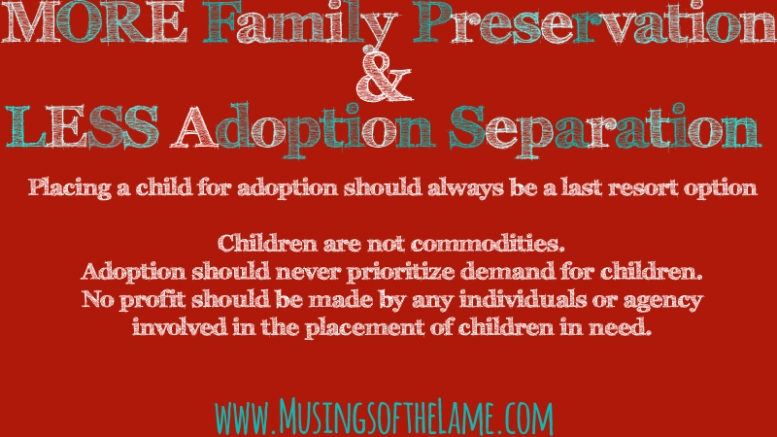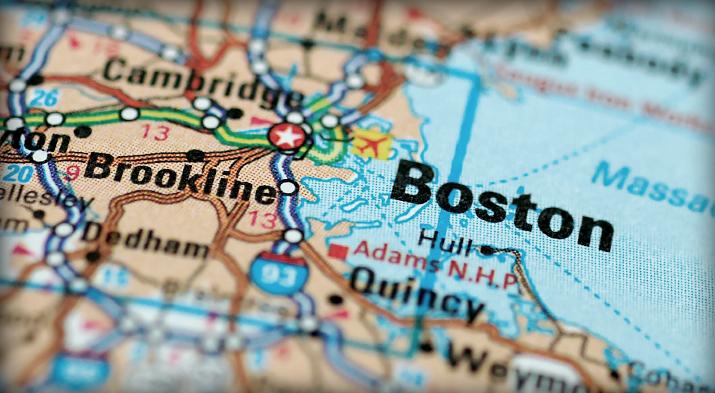By Mirah Riben
If your neighbor lost his job a year after his wife died, and he had three small kids, would you “help” him by taking away his kids?
If a family in your church or congregation’s house burnt down and they had no family to stay with, would you help them by adopting their infant child?
Recently, Ronnie Stewart a Florida minister of the Refuge Church of New Port Richey, and his wife, Krystal, discovered a homeless family out in the rain. They offered to take their two young sons home for a bath and a warm bed, leaving the parents out in the rain. They are now in the process of adopting the one- and two-year-old boys.
While many commended the Stewart’s for their good-hearted gesture, Kerri Sackville takes exception and many commenters agree with her. “Rescuing children” while leaving their family behind is not the most humane response to a tragedy.
What is Family Preservation
Family Preservation is defined here by Child Welfare Information Gateway and here by the National Family Preservation Network.
Quite simply it describes efforts to keep families together and prevent unnecessary out-of-home placement of children.
- Family Preservation recognizes that children need protecting and society’s goal should always be to provide and ensure their safety.
- Family Preservation seeks to have these goals met while respecting and honoring the inalienable right of every child born to remain safely with the mother and/or father who conceived and/or bore him/her whenever possible.
- Family Preservation recognizes that the parent/child relationship is a sacred connection that should not be severed without due cause, for the protection and safety of the child, and only after all means of addressing the problems of the family unit have been exhausted.
- Family Preservation seeks to uphold the constitutional rights of parents as well as expectant mothers and fathers to protect, care for and maintain a bond with their offspring. Family Preservation thus advocates that we treat every mother and father equally without judgment based on age, marital status, physical or cognitive ability, or financial status. It rejects exploiting parental weaknesses in order to commodify their child to meet a demand. It is about providing affordable health and day care to level the playing field.
- Family Preservation is about helping families overcome crisis and remain intact by providing necessary opportunities, resources, options, and help to do so. Mothers and fathers in crisis need to receive objective family-centered option counseling and all the resources, referrals, and support needed to remain as an intact family and to be protected from fraud, coercion and exploitation which separates them from their child.
Mothers and fathers of a child requiring substitute care should be provided legal counsel to be fully aware of their rights and recourse. Such counsel should be paid for by a tax or fee paid into a general fund and not directly by anyone with an interest in obtaining custody of their child.
Family Preservation calls for extended family to be the first resource for children whose parents are not able or willing to care for them and for stranger placements to be a last resort that allow so that the child to may know all of their genetic/DNA contributors.
Family Preservation is not in any way related to right wing so-called “family values” nor is it code for being “anti-adoption.” Family Preservation does not advocate allowing children to remain in abusive or severely neglectful homes nor forcing any mother who does not want her child to parent said child.
The History of Family Preservation
Family Preservation services and initiatives were developed and are promoted in response to an over-reliance on transient and often unsafe out-of-home foster care.
Use of the term Family Preservation can be traced back to 1890s and the negative reaction to the ‘orphan train movement.’ In the 1909 White House Conference on Children it was the top ranked issue.
By 1966 the Casey Family Programs operated to provide and improve — and ultimately prevent the need for–foster care.
The following two organizations are devoted to preserving families in crisis, offering short-term services designed to assist families in crisis by improving parenting and family functioning while keeping children safe:
• The National Family Preservation Network was founded in 1992 to serve as the primary national voice for Intensive Family Preservation and Reunification Services (IFPS & IFRS) and a myriad of state programs, many affiliated with schools of social work.
• Lumos works to help the world’s orphans regain their right to their own family, in the face of high demand for children to adopt. Lumos finds that supporting children to remain in their own communities is more cost effective – in addition to being more humane – than funding institutions. They work with governments, professionals, communities and families to provide resources needed to prevent unnecessary, permanent family separations, such as medical care and education.
• National Institute for Permanent Family Connectedness (NIPFC) operates from the position that “every child has a family, and family members can be found when we try.” We owe our children in need, they say, no less than employing every effort to locate and contact any possible family resource for them, and to do so as quickly as possible. In addition to permanency, children in litigated custody also need and deserve expediency.
• Family Finding “identifies relatives and other supportive adults, estranged from or unknown to the child, especially those who are willing to become permanent connections for him/her.” Working primarily with young adults “aging out” of care the non-profit has successfully located no fewer than 40 relatives or other meaningful connections for each youth.
Why wait, however, to find resources for children in need of extra-familial care? Every state should be mandated to find all extended family resources for every child in their care at the onset of every placement, not when children are leaving care. Not only is it in the best interest and safety of these unmoored children, but will also save taxpayers money to have the children placed with family rather than paying strangers.
The Basis of Family Preservation
These important rights and protections are echoed by UNICEF which stated in a 2007 press release:
“Adoption should always be the last resort for the child. The CRC, which guides UNICEF’s work, states very clearly that every child has to the right to know and to be cared for by his or her own parents, whenever possible. UNCIICEF believes that families needing support to care for their children should receive it, and that alternative means of caring for a child should only be considered when, despite this assistance, a child’s family is unavailable, unable or unwilling to care for her or him.”
“Children have rights. These rights are laid down essentially in the United Nations Convention on the Rights of the Child [UNCRC] and in the Hague Convention on the Protection of Children. Children and their biological parents have a right to respect for their family life.”
“Adoption at what cost?” 2007 Terre des hommes - child relief, Lausanne, Switzerland
The rights of children in the UN Convention on the Rights of the Child (UNCRC) are as follows:
- Article 7:
“The child shall be registered immediately after birth and shall have the right from birth to a name, the right to acquire a nationality and, as far as possible, the right to know and be cared for by his or her parents.” - Article 8:
“Where a child is illegally deprived of some or all of the elements of his or her identity, States Parties shall provide appropriate assistance and protection, with a view to re-establishing speedily his or her identity.” - Article 9:
“States Parties shall respect the right of the child who is separated from one or both parents to maintain personal relations and direct contact with both parents on a regular basis, except if it is contrary to the child’s best interests.”
Further, America’s Uniform Adoption Act of 1994 calls for the protection of “minor children against unnecessary separation from their birth parents.”
Additionally, the United Nations’ Universal Declaration of Human Rights articles 12 and 16(3) address interference with family, stating that “the family is the natural and fundamental group unit of society and is entitled to protection by society and the State.”
Article 25(2) states:
“Motherhood and childhood are entitled to special care and assistance. All children, whether born in or out of wedlock, shall enjoy the same social protection.”
How it Plays out – or Doesn’t – in Practice
“Regrettably, in many cases, the emphasis has changed from the desire to provide a needy child with a home, to that of providing a needy parent with a child. As a result, a whole industry has grown, generating millions of dollars of revenues each year . . .”
The Special Rapporteur, United Nations, Commission on Human Rights, 2003.
Demand for children remains high.
Child protective services are poorly funded and understaffed. As with our legal system, the indigent, the marginalized, disenfranchised and working poor are at higher risk, unequally targeted, and far less able to defend themselves. Their children too often become commodities for more affluent foster and adoptive parents who are viewed as being able to provide a “better” home.
The privatization of American infant adoption has turned what once was a social institution for providing care for children in need – into a multi-billion-dollar unregulated industry run by untrained, unlicensed, unregulated practitioner/baby brokers and intermediaries.
While children need protection, there has never been evidence that the severing of all ties to one’s original family or falsifying one’s vital records is in their best interest. Such state-committed fraud that changes a child name, lists adopters as parents of birth and often changes the child’s place or even date of birth, benefits only gray and black market baby brokers and child traffickers, not adopted persons. Transparency – not secrets and lies – is sorely needed in every aspect of child protection. However, policies are made to protect paying clients and the attorneys and adoption agencies whose livelihood is dependent on the redistribution of children with non-related strangers.
Father Symeon,, BPS Orthodox Christian Conciliation Services Existential Life Coaching, Counseling, Consultancy Services Hermitage of St John the Divine Syracuse NY writes that he is not against adoption in principal but in practice:
“There is so much wrong with Child Adoption worldwide.
“I support its abolition being replaced with a three tier approach 1) Family Preservation: a healthy attempt to keep the child with the parents. 2) Kinship Guardians: a type of adoption by extended family. 3) Guardian Stewardship: a type of adoption by non-familial persons.”
Annette Baran, MSW, and Reuben Pannor, MSW, co-authors and highly regarded adoption experts also favor guardianship over adoption, as it is practiced in the U.S.:
“Relinquishment of children to a new set of parents, as a final, irrevocable act, severing all rights of the birthparents, must be discontinued….
“Instead, we propose a form of guardianship adoption that we believe would be in the best interests of all concerned, with special benefits for the adoptee for it would decrease the abandonment/rejection issue and permit the child to know the birthparents as real people who cared about him but could not raise him.”
Adoption as a humanitarian effort – domestically and internationally – falls pitifully short. There are more humane ways to help families in crisis, than removing children.
Many current American adoption practices are in direct opposition to these child- and family-centered goals. These include:
• Pre birth matching with expectant expenses paid directly from prospective adopters to expectant mothers, which engenders feelings of obligation indebtedness and creates false expectations for adopters.
• Worse still are pre-birth consents. Lawful in two states, they are banned elsewhere for violating the intent of baby selling.
• Presenting open adoption as giving moms-to-be control, inasmuch as promises of ongoing contact are unenforceable in most states.
• Putative father registries which exist to speed up adoptions in violation of the constitutional rights of fathers
• “Safe Havens” – aka legalized abandonment – deny mothers in crisis the opportunity of counseling and denies children any hope of finding the truth of their genetic heredity
• Denying adopted persons access to their authentic original birth certifictes.
Placing a child in the care of adults to whom the child is not related must always be a last resort option to be used only when there are no extended family members able and willing to provide care for the child related to them.
Children are not commodities, and adoption should never prioritize demand for children. No profit should be made by any individuals or agency involved in the placement of children in need. We need more Family Preservation and less adoption separation.
Read at the Source: : Mirah Riben on the Huffington Post










We agree that some children can’t be raised with their parents for many reasons and that they might feel positive about the experiences they’ve had in the care of others – even in some cases building relationships with these people that are ongoing, strong and positive.
But severing ties and creating a false birth certificate isn’t a necessary part of that. It doesn’t logically follow that to protect and care for a child their identity must be changed or invented.
Basing care of a child on changing the child’s identity and denying a previous existence and origins (whether known or not) is not a sound basis for child protection and child development.
Definitely, there will always be a need to remove children from unfit parents. No contest. But changing the child’s birth certificate (adoption) is not about what the child needs at all.
In adoption, child protection becomes inextricably linked with child ownership and becomes – disturbingly often – about those who ‘need’ a child.
Wherever an adoption has ‘worked’, what should be examined is whether great caring with well-balanced, good people lucky enough to have the means to offer care has ‘worked’ instead.
Sharyn white an adult Adoptee
__________________________________________________________
An Alternative to think about
Adoption is the legal severing of that child/adult and their future generations from their family tree. It is the issuing of another birth certificate to say that genetic strangers are their mother and father”,” As if born to “. “The way to get it right is to fundamentally rethink how to provide safe homes to all children.”
NOT permanent removal by means of adoption by people fulfilling their need for a child and governments looking to save money.
Adoption is a past option for today’s children who need care. There are many reasons why families can’t care for their children for one reason or another, for the child to be outside of the natural parent family unit for part or all of their lives.The way to get it right is to fundamentally rethink how to provide safe homes to all children.”
We believe the ideal approach to a stranger care non biological model is one of Stewardship where the child’s welfare is paramount and the personal history transparent.
“Stewardship is the responsible overseeing and protection of someone considered worth caring for and preserving”.
.
As a concept we believe Stewardship to be a modern, realistic framework for moderating the lasting impact of detachment and grief while providing the child with an honest, happy and fulfilling life. We believe adoption is one of the most damaging forms of care, to cut and traumatise a child from their flesh and blood parents, siblings, grandparents, cousins, it’s heritage and Identity.
With current Australian States and Territories’ law there are a number of care options available ranging from kinship care permanent care to adoption.
Overall we believe that the arrangements under a Stewardship model are preferable to adoption because of the greater transparency and optimum involvement of the natural family and because psychologically, over a lifetime, the possibility of harm to all involved is greatly reduced. We believe this to be the least harmful alternative to adoption, which respects the child’s right to their origins and identity
This form of Long term care can currently be initiated when a State Court issues a guardianship Care Order granting custody to a nominated family. Children covered by this type of Order can come to the attention of the Court via Child Protection Services agents or, in extreme cases, voluntary placement by agreement of the parent(s).
The Stewardship family take the role of UNCLE and AUNT’S NOT MUM and DAD like adoption the child grows up with the security of knowing that everyone is looking out for them. Not with a substitute family that tries to replace the child’s family but with a family that is a supportive, loving, safe and nurturing one that supports and includes the child in their family for a lifetime without the child being legally severed from its heritage bloodline, sisters, brothers, grandparents and extended family and without creating a new legal but fraudulent birth certificate that names the non biological couple as the natural parents (AS IF BORN TO) but maintains the child’s birth right to their identity.
Stewardship is a model just like kinship Care is a Model and both are placed and monitored under a guardianship order by the courts. After it has been determined that there has been no coercion, a guardianship order is legally established. In the case of siblings, a stewardship family is chosen that can keep them together. The guardians are responsible for all day-to-day care of the child and for decisions about matters such as education, employment, health and wellbeing. The guardianship order expires when the child reaches age 18/21 and it is assumed that the close relationship established between the guardians/family and the child would last a lifetime. The child is able to be involved in both the guardians/family and their own parents/family lives by choice.Without the added pressure from a replacement family that wants the child to be “As if Born To” them that often exists in adoption.
.
“In a natural family the parents no longer have the legal responsibilities for their child when the child reaches age 18/21 the child becomes legally responsible for themselves, however the relationship between the child and its family does not finish, this is the same with a stewardship model”
Also the court’s involvement is to construct a contact regime for each particular child with immediate family, siblings, grandparents and extended family depending on his or her needs and circumstances, (you can’t say ‘one size fits all) that is legally binding and the guardians are legally bound to support its implementation through until the child reaches the end of the guardianship order and if this is not appropriate the court shall set out and monitor what is appropriate.
Like adoption (Not Foster-care) Stewardship guardians have financial responsibility “AS IF THE CHILD WERE A DEPENDANT”‘ and are supported and resourced by the responsible dept or NGO (another school of thought is that guardians are fully paid and professionally trained). The Order would not automatically affect the child’s inheritance rights and the adult child would have the same rights as the Guardians other children in any Probate/Succession matters.
Unlike adoption, this child-first Stewardship model of care and protection treats the rights and care of the child as paramount and should not be used until all other options have been exhausted. Family preservation should always be the first option, however when there is no other option it should not be adoption
1. Family Preservation (or reunification) first, or, if not possible,
2 A Kinship care model guardianship to relatives or close family friends should be the prefered out of home care option
3. A Stewardship child-first model; stranger care and support through to a lifetime, safe, secure, stable, support family under a Guardianship Order by the court.
Changing an adopted child’s identity was justified to make the child feel more like a member of the family raisin him. Today, however, children live in families with multiple surnames for a variety of reasons.